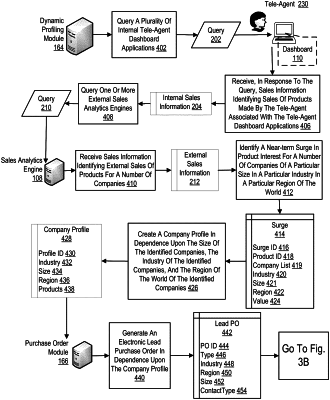| CPC G06Q 10/06311 (2013.01) [G06F 16/90335 (2019.01); G06Q 30/0202 (2013.01); G06Q 30/0205 (2013.01); G06N 5/02 (2013.01); H04M 3/5183 (2013.01)] | 5 Claims |

|
1. A non-transitory computer-readable medium storing instructions, which, executed by one or more processors, implement a lead purchase engine, comprising:
a dynamic profiling module;
a lead purchase order module; and
a dashboard update module, wherein the dynamic profiling module, the lead purchase order module, and the dashboard update module are configured to operate without direct tele-agent intervention to perform operations comprising:
receiving, by the dynamic profiling module from a plurality of tele-agent dashboard applications, sales information identifying sales of products made by the tele-agent associated with the tele-agent dashboard applications,
querying, by the dynamic profiling module, one or more external sales analytics engines and receiving, in response to the query, sales information identifying external sales of products for a number of companies,
parsing the received tele-agent sales and the received external sales information into semantic triples and store the semantic triples in a knowledge graph of a semantic graph database, wherein each semantic triple comprises a respective a subject, a respective predicate, and a respective object, wherein the subjects and objects of the semantic triples are represented by nodes in the knowledge graph, and the predicates are represented by edges in the knowledge graph, wherein each data item in the semantic graph database is represented by a uniform resource identifier (URI), an internationalized resource identifier (IRI), or a uniform resource locator (URL),
performing semantic reasoning of the knowledge graph of the semantic triples to identify a near term-surge in an interest in a product, wherein the identifying comprises identifying the near-term surge from a plurality of nodes of the knowledge graph and relationships among the plurality of the nodes of the knowledge graph, wherein the near-term surge identifies companies purchasing the product and is represented by data specifying the product, a company list being representative of the companies purchasing the product identified in the near-term surge in the interest, an industry, company size information, a region of the world, and a value representing a strength of the near-term surge, wherein performing semantic reasoning of the knowledge graph comprises implementing a probabilistic logic network derived from machine learning,
creating, by the dynamic profiling module, a company profile associated with the near-term surge, the company profile including criteria for one or more companies that are likely candidates to become customers of the product associated with the near-term surge and being represented by data specifying a profile ID, the industry, the company size information, the region, and product information of the product,
generating, by the lead purchase order module, an electronic lead purchase order in dependence upon the company profile,
transmitting, by the lead purchase order module, the lead purchase order to a remote third-party lead generation engine,
receiving, by the lead purchase order module from the lead generation engine, a plurality of leads in dependence upon the lead purchase order,
parsing, by the lead purchase order module, the leads received from the lead generation engine for one or more tele-agents, and
updating, by the dashboard update module, one or more tele-agent dashboard applications to include the parsed leads.
|